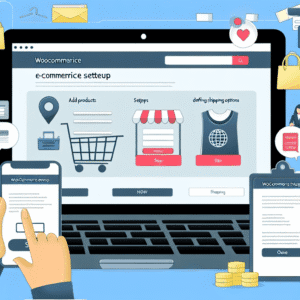In today’s fast-paced digital marketplace, having a sales funnel is not enough—it must be efficient, intuitive, and seamless. Businesses that streamline their sales funnels convert leads faster, retain more customers, and maximize revenue with less friction.
From the moment a potential customer becomes aware of your brand to the time they make a purchase, every interaction should be strategically designed to guide them smoothly through the funnel. In this comprehensive guide, we’ll walk you through the critical stages of the funnel and show you how to optimize each one for greater success.
What is a Sales Funnel?
A sales funnel is a visual representation of the customer journey. It shows the stages a person goes through from discovering your brand to becoming a loyal customer. The traditional stages of a sales funnel are:
- Awareness
- Interest
- Consideration
- Intent
- Purchase
- Loyalty (Post-Purchase)
The goal of streamlining the funnel is to minimize drop-off at each stage and shorten the buyer’s journey without making them feel rushed.
Why Streamlining Your Sales Funnel Matters
A clunky sales funnel creates confusion, frustration, and lost revenue. A streamlined funnel:
- Increases conversion rates
- Improves user experience
- Reduces acquisition costs
- Builds trust and customer loyalty
Let’s now break down the key strategies for optimizing each stage of the funnel to create a frictionless path from awareness to purchase.
Stage 1: Awareness — Make a Great First Impression
At the top of the funnel, your focus is to attract attention and introduce your brand.
1.1. Know Your Target Audience
Before you can attract the right customers, you need to understand who they are, what they care about, and where they spend their time. Create customer personas based on:
- Demographics
- Pain points
- Buying behavior
- Preferred platforms (social media, search engines, etc.)
1.2. Optimize Your Channels for Discovery
Use multiple channels to reach your audience effectively:
- Content Marketing: Write blog posts, guides, or videos addressing customer pain points.
- SEO: Optimize your website and content with relevant keywords.
- Social Media: Create engaging content and ads to spark interest.
- Paid Ads: Use targeted Google or social media ads to reach a broader audience.
1.3. Craft a Clear, Compelling Brand Message
When people first encounter your brand, clarity trumps cleverness. Your value proposition should answer:
“What problem do you solve, and why should someone care?”
Make sure your website homepage, landing pages, and ads communicate this instantly.
Stage 2: Interest — Keep Them Engaged
Once someone is aware of your brand, the next challenge is to hold their interest.
2.1. Create a Seamless Website Experience
Visitors should be able to navigate your site easily and find the information they need:
- Fast loading speed
- Mobile responsiveness
- Clear calls-to-action (CTAs)
- Simple menus and logical structure
2.2. Deliver High-Value Content
Use blogs, webinars, infographics, and videos to educate and engage your audience. Focus on:
- How-to guides
- Product tutorials
- Industry insights
- Case studies or testimonials
2.3. Capture Leads Without Friction
Make it easy and appealing to leave contact information:
- Offer lead magnets (free ebooks, checklists, templates)
- Keep forms short (name + email often suffices)
- Add social proof near forms (e.g., “Join 10,000 subscribers”)
Stage 3: Consideration — Build Trust and Address Concerns
At this point, prospects are evaluating whether your product is right for them.
3.1. Nurture with Targeted Email Sequences
Use automated email campaigns to move leads closer to a buying decision:
- Welcome email
- Educational emails
- Product benefit breakdowns
- Objection-handling messages
Segment your list based on behavior and interests to keep messages relevant.
3.2. Use Testimonials, Reviews, and Case Studies
Build credibility by showcasing real customer success stories. Place these on:
- Product pages
- Landing pages
- Email campaigns
3.3. Offer Free Trials or Demos
Give customers a risk-free way to experience your product:
- Free software trial
- Product samples
- No-obligation consultation
This builds trust and removes barriers to moving forward.
Stage 4: Intent — Make the Decision Easy
Now that the customer is leaning toward a purchase, eliminate any last-minute hesitation.
4.1. Create Clear, Conversion-Focused Pages
Your product or service pages should:
- Emphasize benefits, not just features
- Include clear pricing
- Answer FAQs
- Include urgent, compelling CTAs
Avoid clutter. The page should be laser-focused on converting.
4.2. Use Exit-Intent Popups
If someone is about to leave, a well-timed popup offering a discount or bonus can change their mind.
Examples:
- “Wait! Here’s 10% off your first order.”
- “Book your free call now and get a bonus template.”
4.3. Offer Incentives
Limited-time deals or bonuses help speed up decisions:
- Free shipping
- Limited-time discounts
- Bundled deals
- Money-back guarantees
Stage 5: Purchase — Make Checkout Effortless
A common mistake is making customers work too hard at the final step.
5.1. Simplify the Checkout Process
Remove friction by:
- Allowing guest checkout
- Minimizing form fields
- Providing multiple payment options (credit card, PayPal, etc.)
- Offering one-click checkout (if applicable)
5.2. Offer Real-Time Support
Use live chat, chatbots, or visible contact options during checkout to assist hesitant buyers.
5.3. Confirm and Reassure
After purchase:
- Send a confirmation email immediately
- Provide delivery details or next steps
- Offer customer support info in case of issues
This closes the sale with confidence and clarity.
Stage 6: Loyalty — Keep Customers Coming Back
A streamlined funnel doesn’t stop at the sale. Encourage repeat business and referrals.
6.1. Follow Up With Value
Post-purchase emails can include:
- Thank-you messages
- Product tips
- Upsell/cross-sell offers
- Invitations to join a loyalty program
6.2. Request Feedback and Reviews
This shows you care and gives you content for social proof:
- Ask for reviews via email
- Offer small incentives for completing surveys
- Use feedback to improve the experience
6.3. Build a Community
Invite customers to:
- Join your social media groups
- Subscribe to your newsletter
- Refer friends (with rewards)
Community fosters loyalty and reduces churn.
Tools to Streamline Your Sales Funnel
Here are some powerful tools to help automate and optimize your funnel:
| Function | Tools |
|---|---|
| Email Marketing | Mailchimp, ActiveCampaign, ConvertKit |
| Landing Pages | Unbounce, Instapage, Leadpages |
| CRM | HubSpot, Pipedrive, Zoho CRM |
| Analytics | Google Analytics, Hotjar, Mixpanel |
| Chatbots & Live Chat | Drift, Tidio, Intercom |
| A/B Testing | Optimizely, Google Optimize, VWO |
Common Sales Funnel Mistakes to Avoid
- Too many steps – Complicated funnels lose prospects.
- Generic messaging – Speak directly to your audience’s pain points.
- Lack of follow-up – Not nurturing leads costs you sales.
- No analytics – You can’t optimize what you don’t measure.
- Ignoring mobile – Your funnel must be mobile-first.
Final Thoughts
In the digital age, where attention spans are short and competition is fierce, a streamlined sales funnel is not a luxury—it’s a necessity. By removing friction, guiding customers intuitively, and providing value at every step, you can create a sales process that feels less like selling and more like helping.
When customers feel understood and supported, they’re not just more likely to buy—they’re more likely to return, refer others, and become loyal advocates of your brand.
Start with one stage at a time, audit your current process, and make small, strategic improvements. Over time, these changes will add up to a smooth, profitable funnel that fuels your business growth.
Need help streamlining your funnel? Let us know your current setup, and we’ll offer customized tips to optimize your customer journey.






